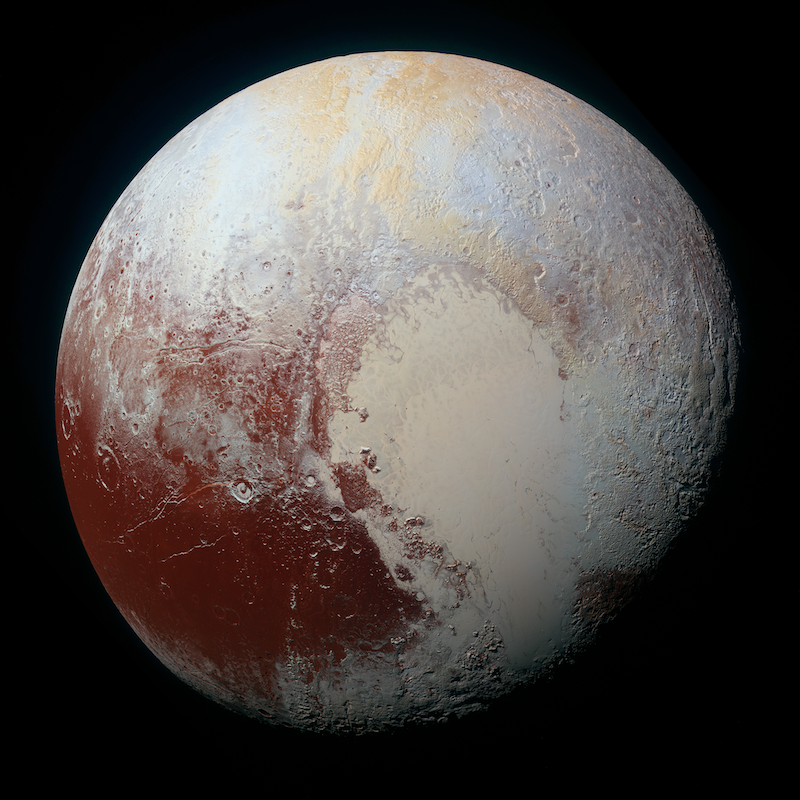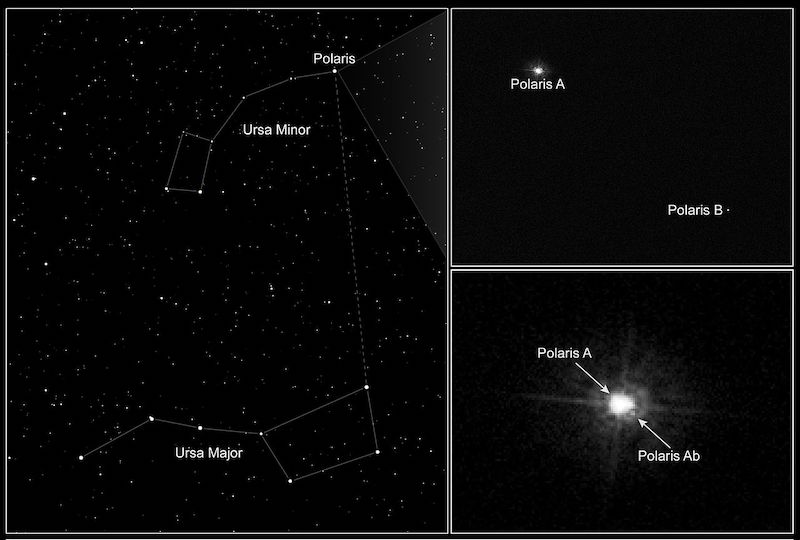Christmas Star
Ask a Rocket Scientist
by Rob Webb on December 16, 2022Name: Mina
Grade: 4
What is your favorite planet or star? Pluto
What is your favorite rocket? Flying Pegasus
Question: Is the star that led the wise men to Jesus still in the sky. If it is could it be the north star?
Thanks for your great question, Mina! I also really like Pluto, even though (by definition) it’s technically no longer considered a planet. Today, Pluto is actually considered a dwarf planet,1 located in the Kuiper Belt, which is part of the outer region (past Neptune’s orbit) in our solar system.
Did you know that Pluto, even though it’s in the far (cold) outer reaches of our solar system, could actually be a geologically active ocean world? Scientists now believe there could be a vast, liquid-water ocean that’s sloshing beneath the surface. And they believe Pluto could be volcanically active today with giant icy volcanoes called “cryovolcanoes”! This is a huge shock for evolutionists (those who believe Pluto was formed billions of years ago),2 but it’s not at all shocking from a biblical worldview. If we start with the Bible, which plainly says that God created every heavenly body on day four of creation week about 6,000 years ago, then it’s no surprise to find Pluto full of geological activity, even with ice volcanoes on it—now that’s a cool (dwarf) planet!

Enhanced color global view of Pluto, taken by NASA’s New Horizons spacecraft. The signature “heart” on Pluto’s surface is believed to be a vast nitrogen glacier.
Photo Credits: NASA/JHUAPL/SwRI
I also really like the Pegasus rocket! It’s one that I used to work on back when I was in the rocket industry. This is a cool rocket because it’s not like normal rockets that lift off from a launch pad on the ground. Instead, the Pegasus rocket launches from the bottom of a huge airplane (Stargazer L-1011) over the open ocean!

L-1011 Stargazer aircraft, carrying a Pegasus XL rocket beneath it, which drops from the aircraft to launch.
Photo credit: NASA/Lori Losey
Now to your question, slightly reworded: What was the star (commonly known as the Christmas Star) that led the wise men to Jesus? Is it the North Star (Polaris) that we see today? Over the years, many people have tried to come up with different explanations of what exactly the Christmas Star was and how it led the wise men to Jesus. So you’re definitely not the first one to ask this type of question!

Polaris as seen by Hubble Space Telescope.
"Polaris alpha ursae minoris" by NASA/HST is licensed under Public Domain
Let me first address the second part of your question. Was the Christmas Star actually the North Star? The simple answer is no. That’s because there was no “North Star” at that time in history.3
Back to the first part of your question, what was this star? Let’s start by looking at the account from the Gospel of Matthew. Sometime after the birth of our Lord and Savior, the “wise men” from the east, known as magi,4 came to Jerusalem, saying, “Where is he who has been born king of the Jews? For we saw his star when it rose and have come to worship him” (Matthew 2:2).

After arriving in Jerusalem, they were told by King Herod to travel to the city of Bethlehem to search for the child. Then, miraculously, “the star that they had seen when it rose went before them until it came to rest over the place where the child was. When they saw the star, they rejoiced exceedingly with great joy” (Matthew 2:9).

Clearly, from the text, this star was no ordinary star! Yet some people still try to come up with natural explanations for it. A few of the more popular ideas is that it could have been a supernova (an exploding star), a bright comet, or a conjunction of planets (when a planet closely passes by a star or another planet).
But, although these are all really awesome events to witness in the sky and would be fitting ways to announce the birth of the King of kings, none of these events fully explain all of the details we read in Matthew, like how the star guided them and stopped over the exact place where the child (Jesus) was located. Plus, for that to actually happen, the star would’ve also had to be relatively close to the earth’s surface. Of course, there is no known natural star/event that can explain these things! (Plus, the Bible never says that this was a natural event anyway!)
Rather, this star was most likely a supernatural event—a miracle.5 Remember that God is not bound by the laws of nature.6 The Bible sometimes mentions supernatural events that God uses to accomplish his purposes, especially regarding Christ, such as the virgin birth or the resurrection. So it’s not surprising that God would use a supernatural sign in the sky to announce the birth of Christ—the Son of God. It’s possible that the “star” was actually a unique display of God’s power.7 But whatever it was, God uniquely designed it for a very special purpose!

On top of that, all natural stars rise in the east. However, the wise men saw the star rising in the west (over Israel) which was likely seen as a miraculous event to them. And from that, they may have known the star was a sign of the birth of Christ (the newborn King) from a prophecy in the Old Testament describing a star coming from Jacob (Israel), the coming of a future King (Christ), “I see him, but not now; I behold him, but not near: a star shall come out of Jacob, and a scepter shall rise out of Israel” (Numbers 24:17).8 So the wise men may have understood this miraculous star (rising from Israel) as the fulfillment of this prophecy.

I sometimes wonder if the wise men knew exactly who the young child was when they met him. Did they know he was the Creator of the universe? And that he came to earth to pay the ultimate penalty (death) for our sins? And that he would conquer the grave so that all who repent (turn from sin) and trust in him would have eternal life?
In any case, regardless of the exact nature of the Christmas Star, this miraculous event should ultimately remind us of the King of kings, who humbly came to earth, being born in a manger in Bethlehem, and who willingly went to a cross to lay down his life and took it up again, so that even today (two thousand years later) all who turn to him in faith will be reconciled with our Creator.
Let earth receive her King! Merry Christmas!

Ask Your Question
Ask a parent to help you submit your space-related question to Rob Webb today! Don't forget to check back next week to see if your question was chosen!
Footnotes
- Dwarf planets are round in shape and orbit the sun (similar to the eight main planets in the solar system) but are much smaller than a planet (even smaller than our moon). According to the International Astronomical Union, which sets definitions for planetary science, a dwarf planet is a celestial body that orbits the sun, has enough mass to assume a nearly round shape, has not cleared the neighborhood around its orbit, and is not a moon.
- On top of all that, there’s hardly any craters on the surface of Pluto, which is yet another huge problem for the evolutionary story!
- This is due to a natural phenomenon called “precession,” which slowly changes the direction of the earth’s rotation axis (like a wobbly spinning top), which then slowly changes the position of the North Star in the sky.
- The magi (pronounced ma’ji’) were considered scholars of the ancient world, generally thought to be from the Media/Persia regions (east of Jerusalem). Since the Bible mentions them bringing three gifts (gold, frankincense, and myrrh) many people commonly assume that there were three magi who visited Jesus. However, the Bible actually doesn’t provide us with the exact number of them.
- A miracle is when God chooses to carry out his will in a supernatural way in specific, rare instances (beyond how he normally upholds everything in the universe).
- The laws of nature are basically descriptions of the way God normally upholds the universe (Hebrews 1:3).
- Some have also suggested that the star could’ve been a directional light that appeared only to those whom God chose to see it.
- Plus, it’s likely the Word of God became well-known in that region due to the previous influence from the prophet Daniel (who lived in Babylon centuries earlier).
- © 2024 Answers in Genesis
- Privacy Policy
- Contact
- About
